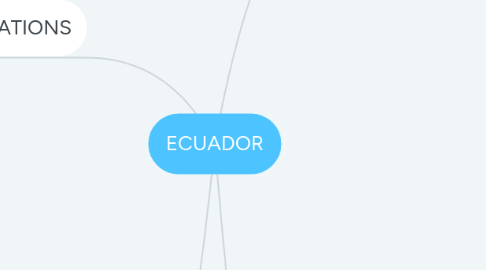
1. U.S RELATIONS
1.1. President Correa has expelled various U.S. State Department representatives
1.1.1. Has at times adopted a brash stance toward U.S. policies
1.2. Also drawn Ecuador closer to nontraditional allies such as China and Iran
1.3. Ecuador joined the Bolivarian Alliance of the Americas (ALBA)
1.3.1. As an alternative to U.S.-led trade partnerships. Ecuador, Bolivia, Venezuela, Cuba, and Nicaragua
1.4. shared interests
1.4.1. in counternarcotics cooperation and democratic strengthening, economic development, and environmental protection in Ecuador
1.5. Counternarcotics
1.5.1. Ecuador is a major transit country for cocaine and heroin with its strategic location
1.5.1.1. Between Peru and Colombia
1.5.2. The government has successfully kept coca from being grown in any significant quantities
1.5.3. Ecuador rejected aid offered by the U.S. government for counternarcotics
1.6. TRADE
1.6.1. U.S.-Ecuador trade issue
1.6.1.1. TEXACO is accused of contaminating large areas of Ecuadorian rainfores
1.6.1.2. Chevron has claimed that Ecuador‘s legal system is corrupt
1.6.1.3. Local judiciaries in Ecuador are politically influenced and cannot provide a fair forum
2. REFERENCES
2.1. June S. Beittel, 2013 Nova Science Publishers, Inc. ECUADOR: POLITICAL AND ECONOMIC CONDITIONS AND U.S. RELATIONS
3. CORREA PRESIDENCY
3.1. Ecuador ended a decade of political and economic instability with the election of Rafael Correa
3.2. New constitution
3.2.1. Increased the power of the president
3.2.2. Allowed the president to run for two consecutive terms
3.3. Ideology
3.3.1. Replication of the leftist policies of his ally, now-deceased Venezuelan President Hugo Chávez
3.4. Government ownership of media has greatly increased during the years of the Correa presidency
3.5. FIRST TERM
3.5.1. Strong economic growth
3.5.1.1. The poverty rate in urban areas declined
3.5.2. The adoption of populist economic policies
3.5.2.1. Included significant public investment including cash transfer programs to those living in poverty
3.5.3. Has increased social spending, expanded government control over strategic sectors
3.5.3.1. Attempted to ensure that a greater share of natural resource revenues go to the state
3.5.4. Is active in many multilateral and international organizations
3.5.5. It is active in regional groups such as the Union of South American Nations (UNASUR)
3.5.5.1. Promotes political, economic, and security coordination
3.5.6. Ecuador is also in the 33-member Community of Latin American and Caribbean States (CELAC)
3.5.6.1. Boost regional integration and cooperation
3.5.7. Is also active in the Organization of American States and many of its associated bodies
3.5.7.1. as well as the United Nations.
3.6. NEW TERM
3.6.1. The law addresses government concerns that the media is mainly in private hands
3.6.2. The law establishes a body to monitor media content and issue sanctions for violations
3.6.3. New mining law
3.6.3.1. Reduce the economy‘s dependence on revenues from oil exports
3.6.3.2. Delaying the windfall tax until miners have recovered their initial investment
3.6.3.2.1. Clarifies guidelines and regulations for mining operations
4. ECONOMIC CONDITIONS
4.1. Is dependent on a few key commodity exports
4.1.1. Petroleum, bananas, shrimp, cut flowers, cocoa and other agricultural products
4.2. Ecuador is the world‘s largest exporter of bananas and plantains
4.2.1. cacao exports are also important
4.2.2. The United States is Ecuador‘s main trading partner
4.3. Has frequently had conflicts with the petroleum industry
4.3.1. has sought to increase state control over the energy sector
4.4. The mineral sector has also been developing
4.5. Ecuador withdrew from efforts to develop a regional free trade agreement (FTA)
4.5.1. United States and Bolivia, Colombia, Ecuador and Peru

